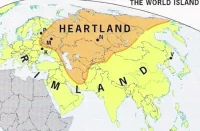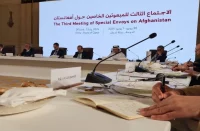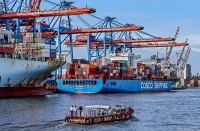There is nothing new in the opinion that has long been expressed regarding the similarity of the military action waged in Afghanistan, after the Soviet army entered the country on December 25, 1979, with the war waged by the U.S. Army in Vietnam. However this opinion leads us away from the truth. By putting its troops in Afghanistan, the USSR blocked the important routes of the world drug trade and forced the flow of drugs to bypass its territory. As for the Vietnam War, even in the United States the view dominates that behind the war in Vietnam were international drug cartels and the CIA, which unleashed the slaughter to eliminate the threat to their interests in Southeast Asia.
Moreover there were tens of thousands of kilometers of Vietnam which posed no threat to U.S. security, while the destabilization of Afghanistan has created a direct threat to the southern borders of the USSR.
The then U.S. Secretary of State Alexander Haig (1981-1982) said: «…Moscow invaded Afghanistan because it was concerned about the strengthening of the belt of Islamic fundamentalism on its southern borders… Between the Soviet Union and Afghanistan there is only the thin line of the Amu Darya River. That is why any successful Islamic movement on the southern border, will inevitably impact on Soviet Muslim republics. Brezhnev’s logic is understandable. The remote possibility that this might happen in the future, forced the Soviet army to enter Afghanistan in 1979».
According to Haig the dangers of the expansion of the Muslim belt zone were confirmed very quickly, when on March 8, 1987 a squad of Mujahedeen fired rockets across the border at the Soviet city of Panj in the Tajikistan SSR, and Gulbuddin Hekmatyar, the leader of the Dushmans, in May of the same year, stated: «If the mujahedeen continue to persist in the fight, the day will come when the occupied lands in Soviet Central Asia will be freed».
These words were neither bravado nor impromptu. A plan to destabilize the Soviet Union by provoking Islamic discontent in Central Asia and the Caucasus was put forward by the Carter administration back in the 1970s (the author of the idea is said to be British intelligence officer and Orientalist Bernard Lewis). The idea was enthusiastically taken up by Zbigniew Brzezinski and those surrounding Carter, who tried to redirect the energy brewing of social unrest and religious protest in the Islamic world against Russia / Soviet Union.

Later, in the mid-90s Brzezinski predicted that the area under Russian care will be fragmented, and remembering the late 1970s, he claimed that the idea of using the Soviet invasion of Afghanistan in order to «drag the USSR into an equivalent of Vietnam «belonged to him and it was then that the U.S. administration accepted the recommendations of the special services» for the first time in the Cold War, to directly support activities aimed at the destruction of Soviet troops.» Also a coalition was created to support the Mujahedeen, which included the United Kingdom, Pakistan, Egypt and Saudi Arabia.
The CIA provided support to the Dushmans about six months before the Soviet invasion, in accordance with a presidential decree by Carter, secret assistance was provided to Afghan «jihad warriors». A total of 120 thousand troops of the Soviet 40th Army, mainly 18-20 year old young men, were confronted by over 170,000 Dushmans, of which over 30,000 had received excellent combat training. In so far as these «devout Muslims» were «fighters for the faith», the evidence shows that over the years of the Afghanistan war, over 5000 mullahs were killed for their loyalty to the Kabul government.
Today the Afghan boomerang thrown by the United States is coming back to them. The Americans have painted themselves into the same corner from which the Soviet Union could not get out in the 1980’s. They are burning enormous amounts of resources in a futile war (in training and equipment alone on almost 340,000 puppet Afghan security forces, Washington has spent more than 20 billion dollars). The Americans spend in one month of fighting in Afghanistan more than the Soviet Union did for an entire year of the Afghan campaign.
Washington’s statements about the success of the Western mission in Afghanistan raise nothing more than sarcastic smiles. In reality there is no sign of a victory for the Western coalition. The war does not subside for a single day. In terms of one of the objectives of the operation – to ensure that members of the ousted Taliban government stand trial, the results of the 11-year campaign are zero. Afghanistan has returned to the «pre-Taliban» fragmented state. Provincial towns and even some villages have announced their independence from Kabul, and some even have their own armed forces. Combat operations take place almost every day.
Frequently the soldiers and officers of the puppet government army, created and funded by the occupiers, are killing NATO troops… American political scientists (e.g. James McAllister) argue that in this sense, what is happening in Afghanistan, «cannot in any way be compared with Vietnam». British analysts (Martin Windrow) in turn, speak of it being «unheard» of for the number of such killings in any military conflict. Indeed, in 2012 the number of cases of liquidation of NATO troops by their «allies» has increased by more than two and a half times – from 11 to 29, in comparison with 2011.
Even the bases and airfields, are subject to periodic attacks by the Taliban, and the Americans do not part with their weapons and radios, and do not remove their body armor and helmets. Information about the real casualties of the U.S. occupation forces in Afghanistan is carefully concealed. Meanwhile, on just one day on September 14, 2012, the U.S. lost 8 attack aircraft – just like in the «best» days of the war in Vietnam. Even according to official data, more than twice as many NATO troops were killed this year in Afghanistan than in the last.
To speak of peace and nation-building success in a country where almost everyone has a «Kalashnikov», many have «Stingers» and some armored vehicles, is at the very least premature. Moreover, more than half of Afghans are unemployed, and grinding poverty reigns. The entire Afghan economy is growing and processing narcotics… According to the UN Office on Drugs and Crime, in 2011 alone, opium production in Afghanistan more than doubled (133%). The area where only illegal raw opium is grown has increased by 7% to 131 thousand hectares.
Almost all the political forces in Afghanistan and many criminal organizations take part in drug production and drug trafficking. Former Interior Minister Ali Ahmad Jalali openly acknowledged that Afghan officials support the drug dealers. The main centers for the dissemination of Afghan drugs are U.S. military air bases in Kosovo, Germany, Italy and Spain, and today for Russia (which takes 20% of Afghan hashish and opium) and Europe (80%), this is one of the major security threats.
The main results of the «anti-terrorist operation» in Afghanistan are currently the start of the «Afghanization» of post-Soviet Central Asia and the tenfold increase in heroin production in occupied Afghanistan. And so the U.S. has crossed «pacified» Afghanistan from its «black list» of countries producing drugs, clearing it of all sanctions. Like the U.S. presidents say, «It is in the vital interests of America».
Source: Strategic Culture Foundation














Comments